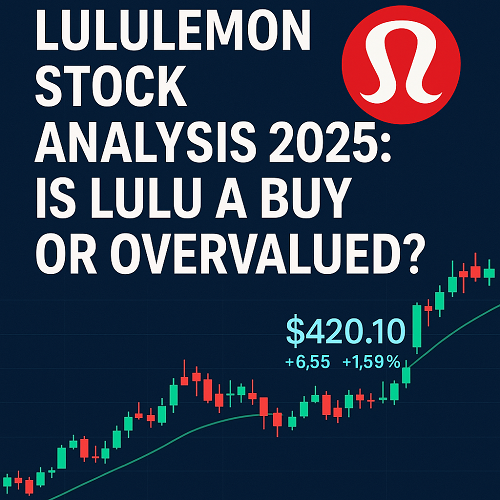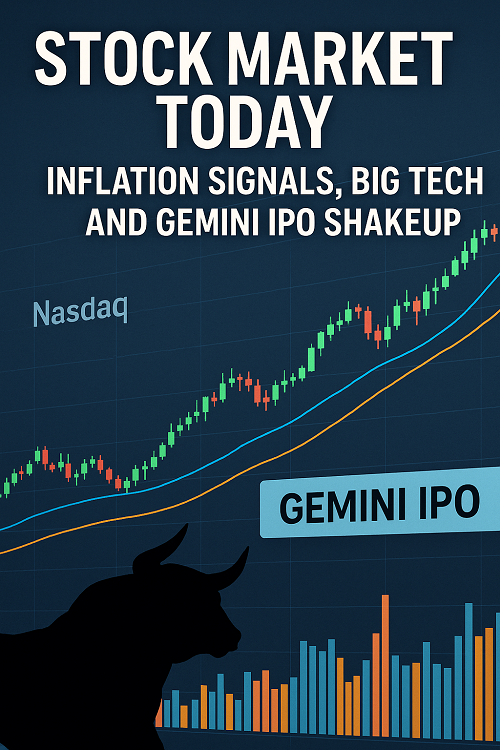Lululemon Athletica Inc. (NASDAQ: LULU) has evolved from a niche yoga-wear brand into one of the world’s most recognized premium athletic apparel companies.
In 2025, as the retail and apparel industry continues to adapt to global macroeconomic headwinds, Lululemon’s performance has drawn the attention of both growth and value investors.
Is LULU stock still a buy at current levels — or has it become overvalued after years of strong performance? This in-depth analysis covers financial performance, valuation, competition, and long-term outlook to help investors make an informed decision.
Lululemon 2025 Financial Summary
| Metric (Fiscal 2025) | Value / Range | YoY Change | Source |
|---|---|---|---|
| Net Revenue (Q2 2025) | US $2.5 billion | +7% | |
| Gross Margin | 58.5% | −110 bps | Same as above |
| Operating Income | US $523.8 million | +5% | Same as above |
| Operating Margin | 20.7% | −30 bps | Same as above |
| Diluted EPS (Q2) | US $3.10 | +8% | Same as above |
| FY 2025 Revenue Guidance | US $10.85–11.00 billion | ≈ +8% YoY | FinancialContent 2025 |
| FY 2025 EPS Guidance | US $12.77–12.97 | ≈ +10% YoY | FinancialContent 2025 |
| Trailing P/E (Oct 2025) | ~27× | — | MarketWatch / Yahoo Finance (Oct 2025) |
| Market Cap (Oct 2025) | ~US $48 billion | — | Nasdaq Data |
| Cash & Equivalents | ~US $1.9 billion | +12% | Q2 2025 Filing |
| Debt | Minimal (long-term < US $1 billion)** | — | 10-Q 2025 |
Company Overview
Founded in 1998 in Vancouver, Canada, Lululemon Athletica Inc. began as a yoga-wear startup targeting a niche community of wellness enthusiasts.
Today, it operates more than 750 stores globally, generates over US $10 billion in annual sales, and competes directly with athletic giants like Nike (NKE) and Adidas (ADDYY).
Lululemon’s success stems from three strategic pillars:
- Premium Brand Positioning – Unlike mass-market peers, Lululemon commands high margins through brand exclusivity and community-based marketing.
- Vertical Integration – It designs, manufactures, and sells directly to consumers, controlling margins and customer experience.
- Product Diversification – While best known for women’s yoga apparel, men’s wear, accessories, and the Mirror / Studio connected-fitness line are expanding revenue streams.
Financial Performance and Growth Trends
Lululemon’s financial trajectory remains impressive in 2025:
- Revenue Growth: +7–8% YoY, fueled by international expansion (notably China + 35%) and men’s segment growth + 18%.
- Profitability: Operating margins above 20% demonstrate best-in-class efficiency in apparel retail.
- Cash Flow: Strong free cash flow (over US $1 billion FY 2024) provides flexibility for share buybacks and store expansion.
However, inventory build-up and slower North American traffic signal near-term moderation.
Global Expansion and Growth Drivers
1. China & International Growth
Lululemon’s international segment is now its fastest-growing, contributing nearly 25% of total revenue.
In 2025, the company accelerated store openings in Asia, while leveraging localized e-commerce and social commerce partnerships.
2. Men’s Apparel
Once an afterthought, men’s apparel is now 30% of sales — with momentum in technical running gear and casual performance wear.
3. Digital and Omnichannel
Lululemon continues to integrate its app, website, and in-store experiences, achieving over 40% of total revenue from digital channels.
4. Product Innovation
From fabric engineering (Luon, Nulu, Everlux) to footwear and accessories, Lululemon maintains a R&D-driven moat that justifies premium pricing.
Fundamental Valuation Analysis
| Valuation Metric (Oct 2025) | LULU | Nike (NKE) | Adidas (ADDYY) |
|---|---|---|---|
| Market Cap | ~US $48 B | ~US $155 B | ~US $48 B |
| P/E (TTM) | 27× | 31× | 29× |
| PEG Ratio | 1.9 | 2.5 | 2.1 |
| Operating Margin | 20.7% | 12.4% | 9.8% |
| ROE | 37% | 32% | 21% |
| Debt-to-Equity | 0.23 | 0.47 | 0.56 |
Interpretation:
Despite a slightly higher P/E than historic norms, Lululemon’s superior margins, growth visibility, and return on equity justify a valuation premium over peers.
Its balance sheet remains one of the cleanest in the industry — a major strength in a tightening monetary environment.
Technical Analysis and Market Sentiment
- Price Range (52-Week): US $326 – US $480
- Current Price (Oct 2025): ≈ US $420
- 50-Day Moving Average: US $415
- 200-Day Moving Average: US $399
Trend: Bullish consolidation. After a pullback in H1 2025, momentum has returned above the 200-day moving average.
RSI: ~61 – nearing overbought but still within an uptrend channel.
Support Levels: $390 / $365
Resistance: $445 / $480
Analyst Consensus: ≈ 60% Buy, 30% Hold, 10% Sell
Average Price Target: ~US $455 (≈ 8% upside)
Risks and Challenges
- U.S. Market Saturation: Domestic sales growth has slowed to +3% YoY as store density increases.
- Currency and Supply-Chain Volatility: Asia-Pacific expansion adds FX risk; margin compression is possible.
- Competition: Nike and Adidas are re-investing heavily in direct-to-consumer (DTC) models.
- Mirror / Studio Headwinds: Connected-fitness hardware remains underperforming post-pandemic.
- Valuation Risk: At 27× earnings, multiple contraction is a risk if earnings momentum slows.
LULU Stock Forecast 2025–2030
| Scenario | Revenue CAGR (2025-2030) | EPS Growth Rate | Implied Price Target (2030) | Assumptions |
|---|---|---|---|---|
| Bull Case | 10–12% | +13–15% | US $700 + | International & men’s growth + margin expansion |
| Base Case | 7–8% | +9–10% | US $520–550 | Steady growth, margin stability |
| Bear Case | 4–5% | +5% | US $350–380 | U.S. slowdown + competitive pressure |
The base-case scenario implies an annualized 8–10% return from current levels, including buybacks but excluding dividends.
Is LULU Stock a Buy, Hold, or Sell?
Verdict: BUY (for long-term investors)
Lululemon remains a premium growth story supported by:
- A globally resonant lifestyle brand
- Strong balance sheet & free cash flow
- Expanding international footprint
- Consistent double-digit EPS growth potential
While valuation is not cheap, its superior profitability and brand equity justify the premium.
Short-term volatility is possible, but LULU appears well-positioned for 2025-2030 growth in the high-end athletic and wellness markets.
FAQs
1. Is LULU stock a good buy for 2025?
Yes — fundamentals, international growth, and financial strength make it an attractive long-term holding, though near-term valuation limits upside.
2. Does Lululemon pay a dividend?
No, the company reinvests profits and conducts share buybacks instead.
3. What is Lululemon’s competitive edge?
Premium brand identity, product innovation, and DTC control yield margins unmatched in the sector.
4. What is the biggest risk for investors?
Slower North American demand and potential margin compression as competition intensifies.
5. How does LULU compare to Nike and Adidas?
Lululemon operates with higher profitability but smaller scale; its valuation is reasonable relative to its growth profile.
Conclusion
Lululemon Athletica (NASDAQ: LULU) continues to embody the blend of growth, profitability, and brand power that long-term investors seek.
Despite cyclical headwinds in U.S. retail, its global expansion, loyal customer base, and innovative culture offer durable advantages.
Bottom line:
For investors seeking exposure to the premium athletic-wear market, LULU is a quality compounder. Patience will likely be rewarded as the company extends its reach and monetizes its brand beyond apparel into global lifestyle and wellness domains.





 XAUT-USD
XAUT-USD  AMD
AMD  MARA
MARA  SHOP
SHOP  BULL
BULL  CL=F
CL=F